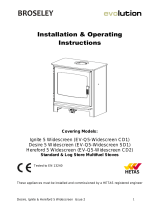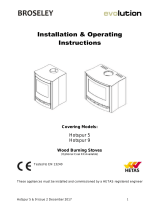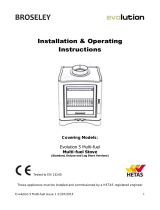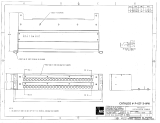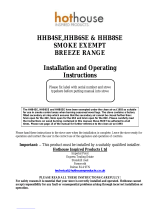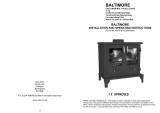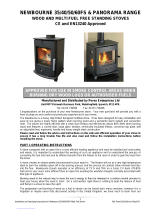Page is loading ...

Desire, Ignite & Hereford Multifuel Issue 8 1
Installation & Operating
Instructions
Covering Models:
Desire 5 (Q5 SD1) Ignite 5 (Q5 CD1) Hereford 5 (Q5 CD2)
Desire 7 (Q7 SD1) Ignite 7 (Q7 CD1) Hereford 7 (Q7 CD2)
Standard & Log Store Multifuel Stoves
Tested to EN 13240
These appliances must be installed and commissioned by a HETAS registered engineer

Desire, Ignite & Hereford Multifuel Issue 8 2
Contents
Introduction 3
Packing List 3
Health & Safety 4
Specifications 5
Dimensions 6
Hearth Requirements & Clearances 9
Chimney Requirements 10
Combustion Air Requirements 11
Direct External Air Supply Requirements 12
Assembly
DEAS Kit 15
Log Store Base 19
Smoke Control Area Modification 20
Internal Components 21
Initial Testing 22
Stove Operation
Controls Layout 25
Controls Explained 26
Fuels 27
Kindling Stage 28
Burning Wood & Burning Coal 29
Smoke Control Areas 30
Warning Notes 32
Maintenance
Door Adjustment 33
Ash Removal 34
Cleaning the Stove 34
Glass Cleaning 34
Chimney Sweeping 34
Chimney Fires 34
Stove Servicing 34
Trouble-shooting 35
Commissioning Form 36
Spare Parts 37
Annual Service Record 38
Warranty 39
Product Fiche 40
Energy Labels 41

Desire, Ignite & Hereford Multifuel Issue 8 3
Introduction
Thank you for choosing one of our multifuel stoves.
The term multifuel refers to the fact that the appliance is capable of burning either wood
logs or coal (that is suitable for closed appliances). Both of these fuels have very
different air requirements in order for them to burn correctly, therefore the air controls
need to be operated differently depending on the fuel being burned (see section “Stove
Operation”).
See the section “Lighting the Stove” for further details. After reading this document, if
there is anything you are unsure about, please contact your dealer or our Technical
Support Department.
These instructions cover the basic principles to ensure the satisfactory installation of the
stove, although detail may need slight modification to suit particular local site conditions.
In all cases the installation must comply with current Building Regulations, Local
Authority Byelaws and other specifications or regulations as they affect the installation
of the stove.
It should be noted that the Building Regulations requirements may be met by adopting
the relevant recommendations given in British Standards BS 8303 and BS EN 15287-1
2007 + A1 2010 as an alternative means to achieve an equivalent level of performance
to that obtained following the guidance given in Approved Document J.
Please note that it is a requirement under the Broseley Fires warranty system that
the installation of the stove is carried out by a Competent Person registered with
a Government approved Competent Persons Scheme. HETAS Ltd operate such a
Scheme and a listing of their Registered Competent Persons can be found on
their website at www.hetas.co.uk.
Packing List
1x Steel Body stove 2x Steel side firebricks 1x Log Retainer
1x Multifunction Tool 1x Steel rear firebrick 1x Blanking Plate
1x Instruction booklet 1x Steel baffle
1x Heat Proof Gloves Set 1x Cast iron grate
1x Spigot (flue collar) 1x Steel Ash pan
All parts will be inside the main stove body upon delivery.

Desire, Ignite & Hereford Multifuel Issue 8 4
Health & Safety
Special care must be taken when installing the stove such that the requirements of the
Health and Safety at Work Act are met.
Installation
This appliance MUST be installed and commissioned by a HETAS registered installer or
competent engineer registered with a government recognised competent person
scheme. Or a fully qualified Heating Engineer in Scotland and Ireland.
Handling
Adequate facilities must be available for loading, unloading and site handling.
Fire Cement
Some types of fire cement are caustic and should not be allowed to come into contact
with the skin. In case of contact, wash immediately with plenty of water.
Asbestos
This stove contains no asbestos. If there is a possibility of disturbing any asbestos in the
course of installation then please seek specialist guidance and use appropriate
protective equipment.
Metal Parts
When installing or servicing this stove care should be taken to avoid the possibility of
personal injury.
CO Alarms
Building regulations require that whenever a new or replacement fixed solid fuel or
wood/biomass appliance is installed in a dwelling an audible carbon monoxide alarm
must be fitted in the same room as the appliance. Further guidance on the installation of
the carbon monoxide alarm is available in BS EN 50292:2002 and from the alarm
manufacturer’s instructions. Provision of an alarm must not be considered a substitute
for either installing the appliance correctly or ensuring regular servicing and
maintenance of the appliance and chimney system.
Fire Guards
When using the stove in situations where children, aged and/or infirm persons are
present a fireguard must be used to prevent accidental contact with the stove. The
fireguard should be manufactured in accordance with BS 8423:2002.
Aerosol Sprays
Do not use an aerosol spray on or near the stove when it is alight.
Operating Tool & Gloves
Always use the operating tool and glove provided when handling parts likely to be hot
when the stove is in use. The tool provided allows you to operate the handle and air
controls.

Desire, Ignite & Hereford Multifuel Issue 8 5
Specifications
In the UK these stoves have been approved by HETAS Ltd as intermittent heating
appliances for burning coal suitable for a closed appliance and wood logs only.
Ignite, Desire &
Hereford 5
(Q5)
Ignite, Desire &
Hereford 7
(Q7)
Nominal Heat Output (Wood) kW
5
7.3
Nominal Heat Output (Ancit) kW
4.9
7.4
Efficiency (Wood) %
82.9
79.4
Efficiency (Ancit) %
81.1
83.4
Weight Kg
Ignite 5 71
Ignite 5 LS 85
Desire 5 68
Desire 5 LS 82
Hereford 5 66
Ignite 7 84
Ignite 7 LS 101
Desire 7 80
Desire 7 LS 97
Hereford 7 77
Flue Diameter mm
125
125
Flue Diameter Inches
5
5
Flue Draft Min Pa
12
12
Flue Draft Max Pa
18
18
Flue Temp (Wood) °C
239
290
Flue Temp (Ancit) °C
210
237
CO Emission (@ 13% O
2
Wood) %
0.46
0.29
CO Emission (@ 13% O
2
Ancit) %
0.54
0.40
Flue Mass Flow (Wood) g/s
3.2
5.2
Flue Mass Flow (Ancit) g/s
Fuel Consumption Per Hour (Ancit)
Fuel Consumption Per Hour (Wood)
3.6
0.7 Kg
1.4 Kg
4.7
1.1 Kg
2.1 Kg
Please note the figures above are without the Smoke Control area stopper fitted, this
modification is required when installing the appliance in a smoke control area. The
spacer will affect these figures, please see the Smoke Control Area section for the
alternate figures. Details on fitting the smoke stopper can be found in the Assembly
section – THE MODIFICATION MUST BE MADE PRIOR TO FINAL SITING AND
CHIMNEY CONNECTION.
European standards need to be complied to when installing this appliance.

Desire, Ignite & Hereford Multifuel Issue 8 6
Dimensions
Ignite 5 & Desire 5
Ignite 5 & Desire 5 Log Store

Desire, Ignite & Hereford Multifuel Issue 8 7
Dimensions
Ignite 7 & Desire 7
Ignite 7 & Desire 7 Log Store

Desire, Ignite & Hereford Multifuel Issue 8 8
Dimensions
Hereford 5
Hereford 7

Desire, Ignite & Hereford Multifuel Issue 8 9
Hearth Requirements & Clearances
The standard (without log store) appliances require a full constructional hearth
with sub-hearth as laid out in building regulations approved document J. Log
store versions are suitable for a minimum 12mm thick hearth.
Your stove must be installed on a solid, level non-combustible hearth. The hearth
protrusion in front of the stove to carpets or wooden floors must be at least 300mm. As
it is possible, that on opening the door of the stove for fuel to fall out, a fender must be
fitted if the hearth is flush with the carpet.
Clearances
The stove requires the following minimum clearances around it to ensure the heat is
released into the room and to allow sufficient combustion air flow. A combustible
material clearance is given to prevent damage to any items that may be affected by
heat.
Product
Material
Rear
Side
Hearth
Above
Ignite, Desire & Hereford 5
(Q5)
Combustible
725mm
550mm
300mm
600mm
Non-combustible
50mm
100mm
300mm
100mm
Ignite, Desire & Hereford 7
(Q7)
Combustible
650mm
500mm
300mm
600mm
Non-combustible
50mm
100mm
300mm
100mm
Please note these are minimum clearances and may not provide sufficient space in your
installation to provide adequate access for maintenance. Ideally you want as much
space around the product as possible to provide access at service intervals.

Desire, Ignite & Hereford Multifuel Issue 8 10
Chimney Requirements
This appliance must not be fitted into a chimney serving another heating appliance. It is
most important that there is no obstruction in the flue or chimney. Please ensure that
any existing chimney is clear of obstruction and swept clean immediately before
installation of the new stove. If the chimney has been used for an open fire it is
recommended that it be swept for a second time having been used for a month
following installation.
A flue draught minimum of 12 Pascals to a maximum 18 Pascals is required for
satisfactory appliance performance. A properly built masonry or factory constructed
chimney (with a minimum vertical height of 5 metres) should ensure a consistent
draught (draw). 45° bends can be used in the flue run (maximum of four bends) you will
need to add an extra 1 metre of vertical flue height for each bend.
The flue draught should be checked under fire at high output and if it exceeds the
recommended maximum, a draught stabiliser must be fitted so that the rate of burning
can be controlled, and to prevent over firing (See section “Warning Notes”). If you have
any doubts about the suitability of your chimney, consult your local dealer/stockist or
engineer. If your flue draft is below the minimum recommendation then it may be
necessary to increase the vertical chimney height, add additional flue insulation or
possibly add a special cowl to the top of the chimney (e.g. anti down draft cowl to
eliminate wind induced down draft).
The outlet from the chimney should be above the roof of the building in accordance with
the provisions of Building Regulations Approved Document J.
If installation is into an existing chimney then it must be sound and have no cracks or
other faults which might allow fumes into the house. Older properties, especially, may
have chimney faults or the cross section may be too large i.e. more than 230 mm x 230
mm. Remedial action should be taken, if required, seeking expert advice, if necessary. If
it is found necessary to line the chimney then a flue liner suitable for solid fuel must be
used in accordance with Building Regulations Approved Document J.
If there is no existing chimney then either a prefabricated block chimney in accordance
with Building Regulations Approved Document J or a twin walled insulated stainless
steel flue to BS 4543 can be used. These chimneys must be fitted in accordance with
the manufacturer’s instructions and Building Regulations.
If a flexible liner or flue system is required the diameter must not be less than 5” /
125mm.
Any bend in the chimney or connecting fluepipe should not exceed 45°. 90° bends are
not permitted. . For top flue installations it is possible to sweep through the appliance by
removing the internal baffle however it is recommended that you provide adequate
access (e.g. easily accessible soot door). For rear flue connection we recommend the
use of a tee section, the bottom of the tee should be capped to catch soot and debris.

Desire, Ignite & Hereford Multifuel Issue 8 11
Combustion Air Requirements
In order for the stove to perform efficiently and safely there should be an adequate air
supply into the room in which the stove is installed to provide combustion air. This is
particularly necessary in modern houses where drafts have been almost eliminated by
double glazing etc.
Under UK building regulations any appliance over 5kW MUST have a fixed permanent
air vent (see building regulations approved document J for detailed information). The
following information is offered as a basic summary of the information found in Building
Regulations. This information should NOT be used as a substitute to following the full
requirements laid out in Building Regulations approved Document J.
Air Vent Calculation Desire 5, Ignite 5 & Hereford 5 (Q5)
For new build properties you will need 5 x 550mm² = 2750mm²
Older properties do not normally need a vent.
Air Vent Calculation Desire 7, Ignite 7 & Hereford 7 (Q7)
For new build properties you will need 7 x 550mm² = 3850mm²
Older properties you will need 2 x 550mm² = 1100mm²
There must not be an extractor fan fitted in the same room as the stove as this
can cause the stove to emit fumes into the room. It is necessary to install a wall
vent to provide the necessary combustion air and to prevent the depletion of
oxygen in the room.
Direct External Air Supply (DEAS)
To use the Direct External Air Supply feature of the product you will need to purchase
and fit the optional Air Box which is supplied as part of the DEAS Kit. Details of how to
attach the Air Box can be found in the Assembly section.
The optional Direct External Air Supply eliminates drafts caused by traditional wall
vents. The DEAS will provide 100% of the operational combustion air. The appliance
has been designed and tested for safety when using Broseley Fires supplied DEAS
Kits. It is therefore essential that only the Broseley Fires DEAS Kits are used when an
external air supply is required.
When fitting the DEAS Kit the following comprehensive installation instructions must be
followed. It is important for the installing engineer to read these installation instructions
before commencing works on a DEAS installation and ensure the instructions for the
DEAS kit are understood as clear and concise.

Desire, Ignite & Hereford Multifuel Issue 8 12
Direct External Air Supply Requirements
Please note that utilising a Direct External Air Supply is only possible once the
optional Air Box has been purchased and fitted to the appliance. The Air Box is
not included in the Broseley DEAS Kit and is sold separately. DEAS kits cannot
be fitted to the stoves without the air box kit.
It is essential that only dedicated external air kits supplied by Broseley Fires are used,
and which is installed in a way that meets all required provisions of the manufacturer’s
instructions, local Building Regulations requirements and appropriate standards. The
details and minimum specification below must be followed at all times. Broseley Fires
stocks the Direct External Air Supply Kit that suits this product. It can be purchased
directly.
DEAS kit Contents
The kit contains the following:
1 x 6x3' Louvre Ventilator – available in White, Terracotta and Buff/Sand.
1 x 6x3' Louvre Back plate with 74.5mm Diameter Spigot
1 x 1.5m of Semi Rigid Aluminium Duct - 80mm Diameter
2 x 80mm Diameter Jubilee Clips
The minimum diameter of duct is 80mm
The maximum total length of the duct is 1.5m
Air box Kit
In order to fit the DEAS kit you will also need to order the air box that attaches under the
stove. There are 2 varieties of air box kits.
5kW Air box kit
5kW Widescreen and 7kW Air box kit
The Air box kit contains the following:
1 x Air Box with fibre seal and fixings
1 x Air Intake Spigot with fibre seal and fixings
Assessment of the Property
Before any installation is carried out using a DEAS Kit the property must be fully
assessed to ensure there is enough ventilation (air-flow) available for combustion during
use and when the door is open for refuel. The following table gives advice on the
properties construction which can have an effect on its air permeability attributes. The
recommendations in this table should be used as a guide at all times.

Desire, Ignite & Hereford Multifuel Issue 8 13
Direct External Air Supply Requirements
Age of property
Refurbished
Type of Ventilation
Recommendation
Post 2008(Class 1)
No
Significantly reduced energy demand due to
air tightness of the building. Typically
double/triple glazed windows with high levels
of roof and cavity insulation. Passive
ventilation through trickle vents and
mechanical extracts in kitchens/bathrooms.
Firstly follow building regs
recommendation on Air Permeability of
the building. Special attention needs to
be made to any extractor in the same
room as the appliance eg: open plan
kitchen diner etc. DEAS Kit can be used
however a risk assessment and
commission testing needs to be carried
out in accordance with HETAS Technical
Note HETAS_TN_0020 v1.0. Extra
ventilation may be required.
Post 2008(Class 1)
House fitted with
Mechanical heat
Ventilation Recovery
System in same room
as appliance
No
Significantly reduced energy demand due to
air tightness of the building. Typically
double/triple glazed windows with high levels
of roof and cavity insulation. Passive
ventilation through trickle vents and
mechanical extracts in kitchens/bathrooms.
Special attention to mechanical heat
ventilation recovery systems is required in
this type of property construction.
Do Not Fit DEAS Kit
Between 1975-2008
(Class 2)
Yes
Reduction to the original energy demand due
to improvements in properties air leakage.
Typical additions include double glazing,
cavity wall and loft insulation and draught
proofing of windows/doors. Typically passive
ventilation through trickle vents and
mechanical extracts in kitchens/bathrooms.
Special attention to mechanical heat
ventilation recovery systems is required in
this type of property construction
Special attention needs to be made to
any extractor in the same room as the
appliance eg: open plan kitchen diner etc.
DEAS Kit can be used however a risk
assessment and commission testing
needs to be carried out in accordance
with HETAS Technical Note
HETAS_TN_0020 v1.0. Extra ventilation
may be required.
If the property has mechanical heat
recovery Do Not Fit the DEAS.
Between 1975-2008
(Class 3)
No
A large proportion of properties fall into this
category and the energy requirement of
these dwellings become greater due to
higher heat loss rates through the building
fabric. They normally have basic passive
ventilation with supplementary mechanical
ventilation incorporated. As the age of the
property increases, the amounts of insulation
incorporated decreases, leading to higher
leakage rates.
DEAS Kit can be used however a risk
assessment and commission testing
needs to be carried out in accordance
with HETAS Technical Note
HETAS_TN_0020 v1.0. Extra ventilation
may be required.
Pre-1975 (Class 4)
Yes
Old style housing with moderate/significant
improvements in the form of double glazing,
inclusion of cavity wall and loft insulation.
Addition of mechanical ventilation in the form
of extract fans in kitchens/bathrooms.
Additional improvements reduce the
properties overall energy requirement.
Special attention needs to be made to
any extractor in the same room as the
appliance eg: open plan kitchen diner etc.
DEAS Kit can be used however a risk
assessment and commission testing
needs to be carried out in accordance
with HETAS Technical Note
HETAS_TN_0020 v1.0. Extra ventilation
may be required.
Pre-1975 (Class 4)
No
Old style housing with single glazing with a
high energy requirement due to increased
leakage through the building structure.
Typically basic passive ventilation through
vents in the wall/floor and by opening of
windows with no insulation or additional
draught proofing measures incorporated.
DEAS Kit can be used. Commission
testing needs to be carried out in
accordance with HETAS Technical Note
HETAS_TN_0020 v1.0.

Desire, Ignite & Hereford Multifuel Issue 8 14
Direct External Air Supply Requirements
Risk Assesment
To carry out a risk assessment it will be necessary to grade the risks associated with
the property, including construction of property and ventilation. HETAS have designed a
risk assessment template that should accompany the table above and be completed at
all times.
It is not recommended that the fitting of the DEAS KIT is made into passive houses with
mechanical ventilation systems or extractors of any kind. In order for the stove to
perform efficiently and safely there should be an adequate air supply into the room in
which the stove is installed to provide combustion air. This is particularly necessary in
modern houses where drafts have been almost eliminated by double glazing etc. Fitting
the appliance into such properties requires
No possible means of air being taken from the room of the appliance eg:
Mechanical ventilation systems
Measures should be taken to ensure the air duct inlet does not become blocked
from snow, debris, and water ingress and not prone to collapse due to heat or
other effects.
The appliance fitted is to undergo stringent commissioning testing as set out in
HETAS Technical Note HETAS_TN_0020 v1.0 and detailed starting page 13.

Desire, Ignite & Hereford Multifuel Issue 8 15
Assembly – DEAS Kit
Air Box
In order to connect a Direct External Air Supply to the appliance you will first need to
purchase the optional Air box Kit. The Air Box kit will need to be fitted to the base of the
appliance as shown below. It is recommended this is done prior to installation of the
stove and or log store.
We recommend removing all loose
components from inside the firebox first, the
stove can then be laid on its back in order
for the Air Box to be attached.
Ensure the fibre seal is fitted between
the base of the appliance and the air box.
Once the Air Box is sealed into position,
return the stove to it’s feet ready for the air
intake spigot to be fitted.
Air Intake Spigot
With the Air Box attached you will next need to add
the air intake spigot to the back of the stove.
Attach the Spigot to the rear of the appliance as
shown using the supplied fixings (ensure the heat
proof gasket is fitted between the spigot and stove
back).

Desire, Ignite & Hereford Multifuel Issue 8 16
Assembly – DEAS Kit
Ducting and Wall Vent
Once suitable risk assessments have been performed the DEAS can be fitted to the
stove. Only Broseley Fires supplied kits should be used.
Step 1.
Using appropriate construction methods (for
the building material of your property) mark
and cut a 80mm diameter hole into the external
wall. Feed the semi rigid ducting through the
hole as pictured (right).
Step 2.
Feed 1 x Jubilee Clip over the opposite end of the duct pipe just fitted through the
external wall. Attach the pipe to the DEAS stub already assembled on the stove.
Tighten the jubilee clip so the duct pipe is secure and sealed. When the connection is
made manoeuvre the stove into positon ensuring the duct is as straight as possible and
not containing any more than 2 bends.

Desire, Ignite & Hereford Multifuel Issue 8 17
Assembly – DEAS Kit
Ducting and Wall Vent
Step 3.
Cut away any excess ducting. Feed the second Jubilee clip over the duct pipe (on the
external facing end). Attach the back plate to the duct pipe and tighten to form a tight
seal. Ensure jubilee clip is tightened in a position whereas it can be inserted into the
hole in the wall cavity leaving the back panel flush with the outer wall. Ensure unwanted
bends are not made in the duct pipe connecting the stove to the back plate.
Step 4.
Fix the back plate to the outside
wall. Screws and plugs to the
external wall are not included. It is
the fitter’s discretion in choosing
screws and fixings suitable for the
external surface. The back plate
should sit flush against the external
wall.

Desire, Ignite & Hereford Multifuel Issue 8 18
Assembly – DEAS Kit
Ducting and Wall Vent
Step 5.
Finally screw the grille ventilator to
the back plate using the 4 x screws
supplied. As mentioned previously
it is important to ensure the air
duct ventilator does not become
blocked from snow or debris and to
prevent water and vermin ingress.

Desire, Ignite & Hereford Multifuel Issue 8 19
Assembly – Log Store
Desire & Ignite Only
It is possible to add (or remove) a log store base to your appliance. The diagram below
shows the locations of the fixings (4x bolts labelled 1) which hold the stove to the log
store base.
When utilising the optional Direct External Air Supply, it is essential that the Air Box is
attached to the base of the stove prior to installation onto the log store base.

Desire, Ignite & Hereford Multifuel Issue 8 20
Assembly – Smoke Control Area Modification
In smoke control areas your appliance will require a small modification in the form of a
mechanical stop on the secondary (wood) air supply (this ensures that the air intake
cannot close beyond the required minimum position).
Fitting the smoke control stop
1) Pull out the Secondary (Wood) slider from the front of the stove.
2) The smoke stopper is fixed through the hole in the slider using the supplied M5 x
6 Button head screw.
3) The screw has a socket head fitting, use an allan key to tighten the screw. The
Installation is now complete.
Please note this modification is only needed on installations located within a
designated Smoke Control Area (consult your local council to find out if the
property falls within a Smoke Control Area).
/

